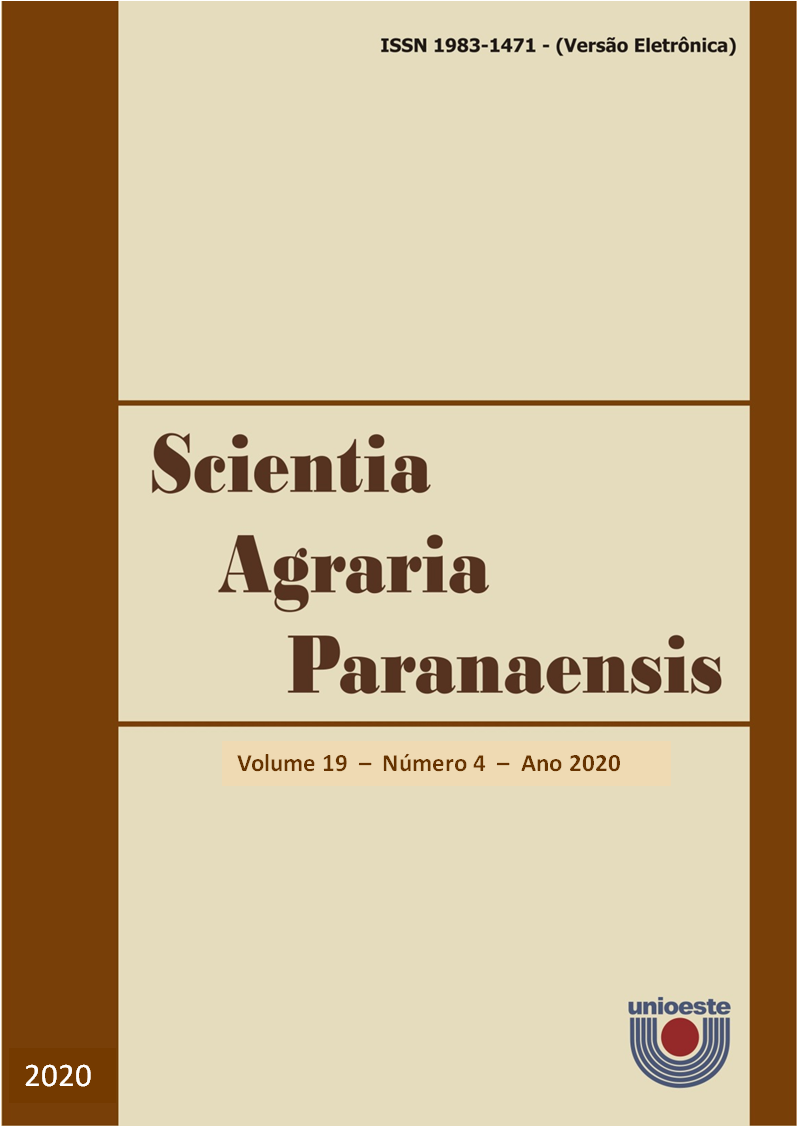Incidence of fungi on yellow passion fruit seeds in the Maranhão State (Brazil)
DOI:
https://doi.org/10.18188/sap.v19i4.25187
Agências de fomento
Resumo
In recent years, passion fruit orchards have suffered from the high incidence of microorganisms, causing damage from the seedling phase to the post-harvest of the fruits; among these microorganisms are the fungi that comprise the largest number of species associated with the seeds. The objective of this work was to evaluate the incidence of fungi associated with yellow passion fruit seeds in the State of Maranhão. The experiment was carried out in 2014 and conducted at the Seed Laboratory of the State University of Southern Maranhão (UEMASUL), Campus Imperatriz. Fruit seeds collected from six municipalities in the state of Maranhão (Carolina, Capinzal do Norte, Estreito, Imperatriz, Vila Nova dos Martírios and São Luís) were used. A completely randomized design with four replications was adopted. A total of 400 seeds were used per municipality, 50 per gerbox, totaling the processing and analysis of 2400 seeds in general. The incidence of pathogenic agents in the seeds was determined by using the filter paper method with freezing, using four replications of 100 seeds per evaluated municipality. Seven days later, the incidence of pathogens was estimated by using a stereomicroscope, with confirmation of the genus and/or species of the fungus. The incidence of Penicillium sp. in yellow passion fruit seeds occurred in all assessed municipalities collected. The city of Vila Nova dos Martírios has presented the highest incidence of fungi, while the city of Imperatriz has had the lowest rate.Downloads
Publicado
30-03-2021
Como Citar
CATUNDA, P. H. A.; SILVA, E. C. da; COSTA, M. A. da S. Incidence of fungi on yellow passion fruit seeds in the Maranhão State (Brazil). Scientia Agraria Paranaensis, [S. l.], v. 19, n. 4, p. 416–419, 2021. DOI: 10.18188/sap.v19i4.25187. Disponível em: https://e-revista.unioeste.br/index.php/scientiaagraria/article/view/25187. Acesso em: 1 jul. 2024.
Edição
Seção
Nota Científica
Licença
Aviso de Direito Autoral Creative Commons
Política para Periódicos de Acesso Livre
Autores que publicam nesta revista concordam com os seguintes termos:
1. Autores mantém os direitos autorais e concedem à revista o direito de primeira publicação, com o trabalho simultaneamente licenciado sob a Licença Creative Commons Attribution que permite o compartilhamento do trabalho com reconhecimento da autoria e publicação inicial nesta revista.2. Autores têm autorização para assumir contratos adicionais separadamente, para distribuição não-exclusiva da versão do trabalho publicada nesta revista (ex.: publicar em repositório institucional ou como capítulo de livro), com reconhecimento de autoria e publicação inicial nesta revista.
3. Autores têm permissão e são estimulados a publicar e distribuir seu trabalho online (ex.: em repositórios institucionais ou na sua página pessoal) a qualquer ponto antes ou durante o processo editorial, já que isso pode gerar alterações produtivas, bem como aumentar o impacto e a citação do trabalho publicado (Veja O Efeito do Acesso Livre).
Licença Creative Commons
Esta obra está licenciada com uma Licença Creative Commons Atribuição-NãoComercial-CompartilhaIgual 4.0 Internacional, o que permite compartilhar, copiar, distribuir, exibir, reproduzir, a totalidade ou partes desde que não tenha objetivo comercial e sejam citados os autores e a fonte.


